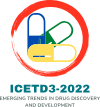Conveners
Keynote Lecture: Session 1
- Trishna Bal (Birla Institute of Technology, Mesra)
- Papiya Mitra Mazumder (Birla Institute of Technology, Mesra)
Keynote Lecture: Session 2
- Neelima Sharma (Birla Institute of Technology, Mesra)
- Barij Nayan Sinha (Birla Institute of Technology, Mesra)
Keynote Lecture: Session 3
- Sandeep Kumar Singh (Birla Institute of Technology, Mesra)
- Animesh Ghosh (Birla Institute of Technology, Mesra)
Herbal medicine is widely used globally to treat various diseases. Even though it does not lead to an immediate cure, the side effects are less compared to allopathic medicine. Cancer is one of the dreadful diseases killing millions of people worldwide. Antibiotic resistance is the major problem to tackle now as resistance had developed to many antibiotics. Discovery of new antibiotics is...
Sickle cell disease is an inherited blood disorder that affects red blood cells. People with sickle cell disease have red blood cells that contain mostly hemoglobin S, an abnormal type of hemoglobin. The most common being Sickle Cell Anemia (SS), Sickle-Hemoglobin C Disease (SC), Sickle Beta- Plus Thalassemia and Sickle Beta-Zero Thalassemia. Health maintenance for patients with sickle cell...
Nanotechnology is an important area of science developed in 21$^{st}$ century, and it is being further advanced with time. Various new and modern technologies are utilized to produce different nanomaterials and nanoparticles now-a-days, and these are used in various fields of industries and society. Due to their random use, the nanomaterials are dumped improperly affecting the environment...
The rise of antimicrobial drug resistance (AMR) in tuberculosis (TB) and non-tubercular mycobacterial (NTM) infection coupled with the shortage of new antibiotics has elevated the global infectious disease to a major global health priority. Our studies revealed that carprofen, a non-steroidal anti-inflammatory drug (NSAID), inhibited the growth of replicating, non-replicating and...
Cannabinoids are the compounds that bind to cannabinoid receptors (endocannabinoid system), and they are one of the most-investigated groups of natural products. Cannabis sativa L. (family: Cannabaceae), an herbaceous medicinal plant from Central Asia, produces most of the ca. 150 naturally occurring cannabinoids, which are commonly known as ‘phytocannabinoids’. Among them,...
Assessment of pharmacokinetic (PK) drug-drug interaction (DDI) is an important requirement of drug development. This is necessary because characterizing the clinically relevant DDIs inform the dose adjustment strategy in patients receiving polypharmacy. However, typical drug development trials are restricted to adult population only (i.e., excluding children) due to ethical and logistical...
Computational studies are an essential part of research in Biochemistry today. The goal of theoretical investigation of biochemical processes is to gain a deeper insight into the molecular mechanism behind the process of study. It can further be used to predict the results of experiments. Protein Bioinformatics is a useful technique to understand biochemical processes of proteins on various...
Nanotechnology is revolutionizing global industrial output and pharmaceutical industry is showing immense interest in nanoproducts owing to the emerging era of infectious diseases. The global nanotechnology healthcare market is expected to grow at a CAGR of around 11.9% in the period ranging from 2020 to 2026 and is estimated to reach USD 461, 252 million by 2026. The sole share of this...
Biomaterials can be considered safe, but at nano size even a biomaterial can pose serious toxic issues to humans as well as a threat to the environment when compared to their macro or micro-sized counterparts. In humans, due to small size of nanocarriers, they can easily cross biological membrane and long exposure leads to their accumulation in cells, tissues and blood. Nanocarriers have...
